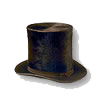Civil War Personalities
Civil War personalities were a diverse group of individuals who showed that perseverance and determination were needed for success. Some people were famous, some unusual, and some were distinguished leaders. Although differing in methodology, they were achievers with principles. They were on both sides of the conflict. For some, their persistence was recognized and rewarded immediately, but for others, recognition came later after they died. They remind us that through determination, grit, and a bit of luck anyone can overcome their circumstances and achieve extraordinary success.
From the first shots on April 12, 1861 at Fort Sumter to the surrender at Appomattox Courthouse, the war was a life-changing experience.
Follow up on these notable individuals...
Abraham Lincoln
—from log cabin to the White House!
Jefferson Davis
—from U.S.Congress to president of the Confederate States of America!
Andrew Carnegie
—from Pittsburgh to Washington, DC and back as a business entrepreneur!
Clara Barton
—from office clerk to celebrated humanitarian!
Horace Greeley
—eminent newspaperman!
Matthew Brady
—from New York City to battle as war photographer!
Union Leaders
Anderson, Robert—Major; commander of Union forces at Ft. Sumter, South Carolina
Buell, Don Carlos—Brigadier General; Battle of Shiloh
Burnside, Ambrose—Brigadier General;
Chase, Salmon P. — Secretary of Treadury
Custer, George Armstrong—General;
Douglas, Stephen A.—Illinois senator who first ran against Lincoln for the Senate and then as a presidential candidate.
DuPont, Samuel F.—Navy Flag Officer
Farragut, David G.—Navy Flag Officer; Battle of New Orleans
Foote, Andrew—Navy Flag Officer; Capture of Fort Henry, Tennessee, with General Grant
Grant, Ulysses S.—Brigadier General; Union Army leader
Halleck, Henry W.—Major General; general in chief
Hancock, Winfield Scott—Major General; Battle of Chancellorsville; Battle of Gettysburg; Battle of Cold Harbor
Hooker, Joseph—Major General; Battle of Chancellorsville
Johnson, Andrew —
Lincoln, Abraham— president of United States
Meade, George G.—Major General; Battle of Gettysburg
McDowell, Irvin—Brigadier General; First Battle of Bull Run
McClellan, George B.—Major General; Battle of Antietam; Peninsula Campaign
Palmer, William Jackson—General
Pope, John—Major General; Second Battle of Bull Run
Rosecrans, William S.—Major General; Battle of Chattanooga, Tennessee
Scott, Winfield—General; noted for his "Anaconda Plan" strategy
Seward, William H.
Sheridan, Philip H.—Major General
Sherman—Brigadier General William T.; Battles in Tennessee and Georgia leading to his infamous "March to the Sea"
Stanton—Edward M.
Welles, Gideon
Confederate Leaders
Anderson, Robert—Major; Ft. Sumter commander of Union forces
Buell, Don Carlos—Brigadier General; Battle of Shiloh
Benjamin, Judah — Attorney General; then, Secretary of War
Beauregard, Pierre G. T. — Brigadier General; Battle of Shiloh, Tennessee
Bragg, Braxton — General; Battle of Chattanooga, Tennessee
Davis, Jefferson — president of the Confederate States of America; former U.S. senator
Early, Jubal — Major General; Battle of Gettysburg, Pennsylvania
Forest, Nathan Bedford — Brigadier General;founder of Ku Klux Klan after the war
Hill, A. P. — General; Battle of Gettysburg, Pennsylvania
Jackson, Thomas J. "Stonewall" — Major General; Second Battle of Bull Run; Harpers Ferry; Battle at Antietam, Maryland; Battle of Chancellorsville, Virginia
Johnston, Albert Sidney — General; Battle at Shiloh, Tennessee
Lee, Robert E. — General; Confederate army leader
Longstreet, James —Major General; Battle of Chickamauga, Tennessee
Morgan, John Hunt — Cavalry officer who invaded Ohio but was captured
Quantrill, William C. — Colonel most noted for his Kansas raids (called Quantrill's Raiders) and rode with the notorious James brother outlaws
Stephens, Alexander H. — Confederate vice president
Stuart, James Ewell Brown (J.E.B) — Brigadier General; Battle of Chancellorsville; Battle of Gettysburg
OF NOTE: Slang and Idioms
The term "cracked up" may refer to when ladies of this period applied beeswax as a facial mask makeup treatment. Women had to partially melt the beeswax beforehand, apply it to the face, then allow it to set up or harden. If the lady smiled or laughed though, the wax would crack up all over the face. Today, when we see someone laughing a lot, we mean that they are "cracking up."
Return to the top of Civil War Personalities...
Share this site with your friends and associates using this link!


